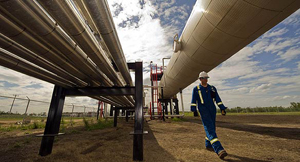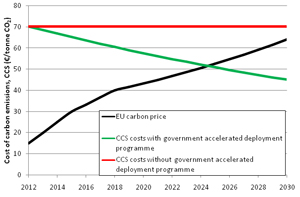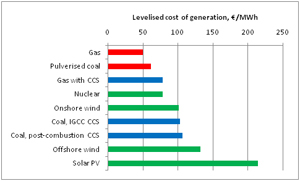How CCS can transform our energy future
on
How CCS can transform our energy future
Carbon capture and storage (CCS), perennially described as an 'unproven' or 'non-commercial' technology, should be able to shake off those tags over the next few years - and emerge as one of the pillars of Europe's and the world's future energy supply, argues author and energy expert Robin Mills. With CCS, writes Mills, we can continue to use our massive fossil fuel resources for the benefit of people across the globe. "CCS offers a qualitative change to climate strategy, a third dimension beyond efficiency and renewable energy. Rather than the static aim of sustainability, carbon capture adds to the energy system's resilience."
 |
| Inspection of the carbon capturing research facility near Redwater, Canada (photo: John Ulan/Canadian Press) |
It’s three steps back, four steps forward for one of the key technologies for fighting climate change: carbon capture and storage (CCS). Many carbon capture projects have recently succumbed to the ‘Valley of Death’, between research and commerciality, that traps many innovative energy technologies.
In October, the UK government declared that it would not fund the sole remaining entrant in its CCS competition, Longannet in Scotland, the third-largest coal power station in the EU. The $4 billion ZeroGen project in the Australian state of Queensland went into liquidation. And power company Ameren announced on November 10th that its financial situation prevented it from taking part in the US’s flagship CCS project, FutureGen 2.0. This has led to some gloom among CCS-developers.
Yet other projects are making progress. China is leading the way, with a large CCS pilot already operational near Shanghai, and others on their way in Tianjin and Inner Mongolia. In the US, Mississippi’s Kemper County coal plant commenced construction in June last year, and is set to be the world’s first full-scale CCS project in power generation. In April, Canada gave the green light to two full-scale CCS projects, at Shell’s Scotford oil sands upgrader and the Boundary Dam power plant. And, stepping into the gap left by Longannet, Shell and Scottish & Southern Energy agreed to work on fitting CCS to a gas-fired plant at Peterhead near Aberdeen.
With CCS making distinct but uneven progress, four broad groups of questions arise. Is it feasible and safe? Is it commercial, able to compete with other low-carbon technologies? Is it necessary, and what role does it play? And what policies are needed to support its introduction?
Safe and feasible?
CCS extracts carbon dioxide from the flue gases of power plants burning coal, oil, gas or biomass, and from other industrial processes, and disposes of it safely and permanently deep underground, or re-uses it as a feedstock. It thus squares the circle: how to make use of abundant, cheap and reliable fossil fuel resources without causing disastrous climate change.
CCS is essentially a large, but straightforward chemical engineering problem – the issue is not feasibility, but bringing down costs through experience and replicability. Reinhardt Hassa, former CEO of Vattenfall, one of the leading power companies involved in CCS, has stated in an interview in the Financial Times, “The technology will function. I’m sure. I’m absolutely sure”.
So far, about 115 megawatts of pilot CCS power projects are in operation, enough to show that the technology works at close to commercial scales. CO2 injection has been used for decades in the oil business to enhance oil recovery, and carbon dioxide has been disposed since 1996 at Statoil’s Sleipner field in the Norwegian North Sea. Bloomberg New Energy Finance estimates that by 2017, 3.2 gigawatts (3200 megawatts) of CCS-equipped systems will be running, close to half today’s solar power output.
Scientific evidence suggests safety concerns are exaggerated. A recent Edinburgh University study of natural seeps in Italy determined that the risk of death from poisoning from exposure to underground
| Many of those who dismiss CCS as an 'unproven' technology are willing to bet on the doubtful feasibility of running an entire major economy on renewable energy alone |
Underground oil and gas reservoirs, and indeed natural CO2 accumulations, have generally held their contents safely for millions, indeed in some cases more than a billion years, without major leakage. Over time, CO2 dissolves in the saline waters underground, sinks, and reacts to form solid minerals. Leakage from well-chosen storage sites should be minimal, almost certainly less than 0.1 percent per year: the longest-running CO2 storage operation, Norway’s Sleipner, is carefully monitored via a variety of methods, and shows no leakage after 15 years of operation.
Geological surveys suggest that most parts of the world have sufficient underground capacity to store a century or more of likely captured emissions.
CCS competitiveness
Studies for the UK government, by the International Energy Agency (IEA), the US’s Energy Information Administration (EIA) and other bodies broadly concur: coal- and gas-fired plants with CCS deliver electricity at comparable costs to nuclear and onshore wind, and much more cheaply than offshore wind and solar power (as shown in the chart). Because of this, and since some major energy-consuming regions have limited renewable energy potential, the IEA estimates that ruling out CCS would raise the already-vast cost of meeting climate goals by 70 percent.
But much renewable energy is equally uncompetitive – the difference obscured by generous subsidies and mandates. German solar power may cost as much as €300-500 per tonne of avoided CO2, and before recent cuts, Germany was expected to pour €13 billion into solar subsidies this year. This compares to just €5 billion from the so-called ‘New Entrant Reserve’ (NER) that the European Commission has for carbon capture and innovative renewable technologiesin its Emission Trading Scheme (ETS) – and this is across the whole of the EU. Yet Greenpeace complains that CCS “is expensive” and would “divert investments” away from renewables.
Intermittent renewable energy sources such as wind and solar power require back-up to meet demand peaks or lulls in supply. Geographic diversification of renewable sources, long-distance electricity transmission, energy storage, load-following nuclear power, dispatchable renewables such as biomass or geothermal, and demand management all form parts of the solution.
But flexible fossil-fuelled generation remains the easiest and cheapest way to match renewable output to demand. No doubt, with experience, new operating techniques will be devised to make CCS-equipped plants more responsive. For instance, the solvent used to strip CO2 from the flue gases can be regenerated at times of low demand, and stored for use in high-demand periods.
CCS plants may well suffer from NIMBY issues – as with the cancellation of Shell’s plan to dispose of CO2 from an oil refinery under the town of Barendrecht in The Netherlands, and with public and political opposition in Germany. In Europe, this may require more use of expensive offshore sites.
| There is not too little carbon in the ground to be dug up and burnt, but too much |
A bridge or a destination?
Globally, CCS is one of the core technologies for tackling climate change. Even by 2050, fossil fuels are expected to supply 50% of electricity generation, and gas- and coal-fuelled plants provide reliable, dispatchable power. The IEA estimates that CCS could account for one-fifth of the total required mitigation efforts to avoid catastrophic climate change, making it the largest single contributor after energy efficiency.
Many of those who dismiss CCS as an ‘unproven’ technology are willing to bet on the doubtful feasibility of running an entire major economy on renewable energy alone. Fukushima demonstrated again the truth of Churchill’s dictum on energy security: “On no one quality, on no one process, on no one country, on no one route, and on no one field must we be dependent. Safety and security...lie in variety and variety alone.”
If the ‘rate shock’ recently seen in Germany and Spain over swelling alternative energy subsidies recurs, if a major blackout is blamed (even incorrectly) on growing renewables penetration, or if renewable energy runs into cost pressures or a slowdown in technological progress, the fight against climate change will suffer a serious blow. This makes a diverse portfolio of options indispensable. Tackling climate change is too important for us not to have a Plan B.
Carbon capture also fills a yawning gap in current CO2 policy – industrial, non-power emissions. Processes such as iron and steel manufacture, oil refining and petrochemicals produce substantial
| Coal miners and coal-based utilities in particular must realise that there is no future for them without CCS |
Existing electricity plants have long lives: a coal power station may easily operate for 60 or 70 years. German nuclear plants, scheduled for decommissioning following the Fukushima accident, are mostly being replaced, not with renewables, but with 10 GW of new fossil-fuelled generation, mainly hard coal with some lignite (brown coal), the dirtiest fossil fuel, and gas. China’s coal power plants, famously built at the rate of one per week, are also the most modern supercritical and ultra-supercritical designs.
This new, efficient and very costly generating fleet will not be decommissioned overnight. Once CCS becomes standard for new fossil-fuelled generation, attention will turn to retrofitting existing facilities.
CCS provides a way of bridging political and energy security concerns. Large coal-producing regions – China; India; South Africa; Poland in the EU; West Virginia and Wyoming in the US; Victoria and Queensland in Australia – depend on coal for jobs and domestic energy, and have substantial political weight.
These political interests have played a crucial role in delaying or watering-down climate policies – CCS offers a way of bringing them on board. As Daniel Weiss, Director of Climate Strategy at the Center for American Progress, observes: “Politically, you can’t pass legislation without support from coal states”. And the massive human resources, expertise, finances and asset base of the conventional energy business can be enlisted on the side of fighting climate change – rather than perpetuating draining battles of the lobbyists.
The successful introduction of CCS has profound implications for future energy policy. Combined with recent breakthroughs in fossil fuel extraction, it could change the whole picture of future energy – which,
| Europe still has the chance to be a leader in carbon capture. But it is already falling behind China and Canada |
Gas is often proposed as a short-term ‘bridge fuel’ to a zero-carbon future. But given the centuries’ worth of resources now known to be available, gas with CCS can instead be a ‘destination fuel’ – one of the pillars of future energy into the 22nd century.
Making CCS a reality
The need now is for more commercial-sized, repeatable projects. Various technology approaches have to be tested at scale, and costs have to come down via experience. There are some exciting breakthrough CCS methods under investigation which have the potential dramatically to lower capture costs and improve energy efficiency. But research and development (R&D) alone is no longer enough to move CCS forward.
The UN’s Clean Development Mechanism (CDM) recently approved carbon capture to receive carbon credits. But EU carbon prices currently are too low to pay for the first generation of plants. Hence government support is required until the technology improves and carbon prices rise as climate policy becomes more stringent. This is exactly the same special targeted support that solar, wind and other low-carbon technologies received in their infancy (and continue to receive).
Early support for CCS can dramatically accelerate deployment and save costs in the longer-term.In the example below, with accelerated deployment, carbon capture could be commercial on the basis of the carbon price alone by the mid-2020s, but not even by 2030 if we wait passively for rising carbon prices on their own.
 |
| Cost of carbon emissions, CCS (€/tonne CO2) - click to enlarge |
Of course, corporations also need to show boldness and imagination in furthering carbon capture. Coal miners and coal-based utilities in particular must realise that there is no future for them without CCS. But the billion-euro price tag of a demonstration plant is too much to risk – the technology is solid enough, but government policy is unstable.
The Zero-Emissions Platform, an EU industry alliance, has laid out a plan for systematically testing different CCS options, but funding difficulties in the midst of the economic crisis have shrunk the original programme. The firepower of the New Entrant Reserve, the funding source for EU projects, has fallen with the price of carbon emission allowances.
It is important for the EU to engage with other regions which have their own unique strengths. China and the oil-rich Persian Gulf states have potentially large amounts of money available, and fewer problems of public acceptance of CCS. China has particular skills in coal-based chemical engineering. The Gulf countries have large, cheap storage options available for enhanced oil recovery, and in some cases low-cost gas supplies for demonstrating gas-based CCS. This is of particular importance to a country such as Qatar, with more than two hundred years’ worth of gas reserves.
Fixing a hole
European companies such as Siemens, Alstom, Vattenfall, Statoil, Shell and BP are leaders in parts of the CCS chain. But as with other ‘green’ technologies, technological expertise will migrate to other regions if not backed by a robust domestic market. Largely due to the failings of others, Europe still has
| Rather than the static aim of sustainability, carbon capture adds to the energy system's resilience - the ability to react to unexpected changes, whether of technology, economics, politics or climate |
Carbon capture can fill several of the holes in current European energy policy – the high cost of renewables beyond onshore wind; the need for reliable low-carbon baseload and dispatchable generation in the face of public opposition to nuclear power; continued reliance of some members on domestic coal; and avoiding premature abandonment of the existing stock of fossil-fuelled generation.
In the near-term, substantial financing is required to realise this vision – not easy in the current economic climate. Yet other low-carbon technologies are already receiving heavy subsidies, even if not so visibly. By working intelligently with other nations, Europe can still realise the main objectives of a CCS demonstration programme at lower cost.
CCS offers a qualitative change to climate strategy, a third dimension beyond efficiency and renewable energy. Rather than the static aim of sustainability, carbon capture adds to the energy system’s resilience – the ability to react to unexpected changes, whether of technology, economics, politics or climate.
The road to the first commercial-scale carbon capture power plants has been a long one. With Peterhead and others on the way, low-carbon fossil fuelled electricity is close to being a reality. The EU, and the global energy business, has to be ready to seize the opportunity.
|
Air capture: extracting CO2 from the air As a recent report from the UK's Institution of Mechanical Engineers suggested, one variant of CCS also offers a solution to the two most intractable climate problems: how to deal with emissions from transport; and what to do about past emissions of CO2 now in the atmosphere. This variant, air capture, extracts the CO2 directly from ambient air. And against frequent dismissals that CCS should be abandoned in favour of reforestation, these 'artificial trees' can capture thousands of times more carbon dioxide than real trees. |
|
About the author Robin M. Mills is Head of Consulting at Manaar Energy (Dubai), and author of The Myth of the Oil Crisis and Capturing Carbon. He can be contacted at robin@oilcrisismyth.com and Twitter: @robinenergy. |
|
More on CCS on EER Here are some of the major articles we published about CCS on European Energy Review in the past few years: Finally, the battle plan for the CCS revolution by Karel Beckman To get an exhaustive overview of our coverage, click on Files on the Homepage, select the option Search Files, and select "carbon capture and storage" under themes. |



Discussion (0 comments)